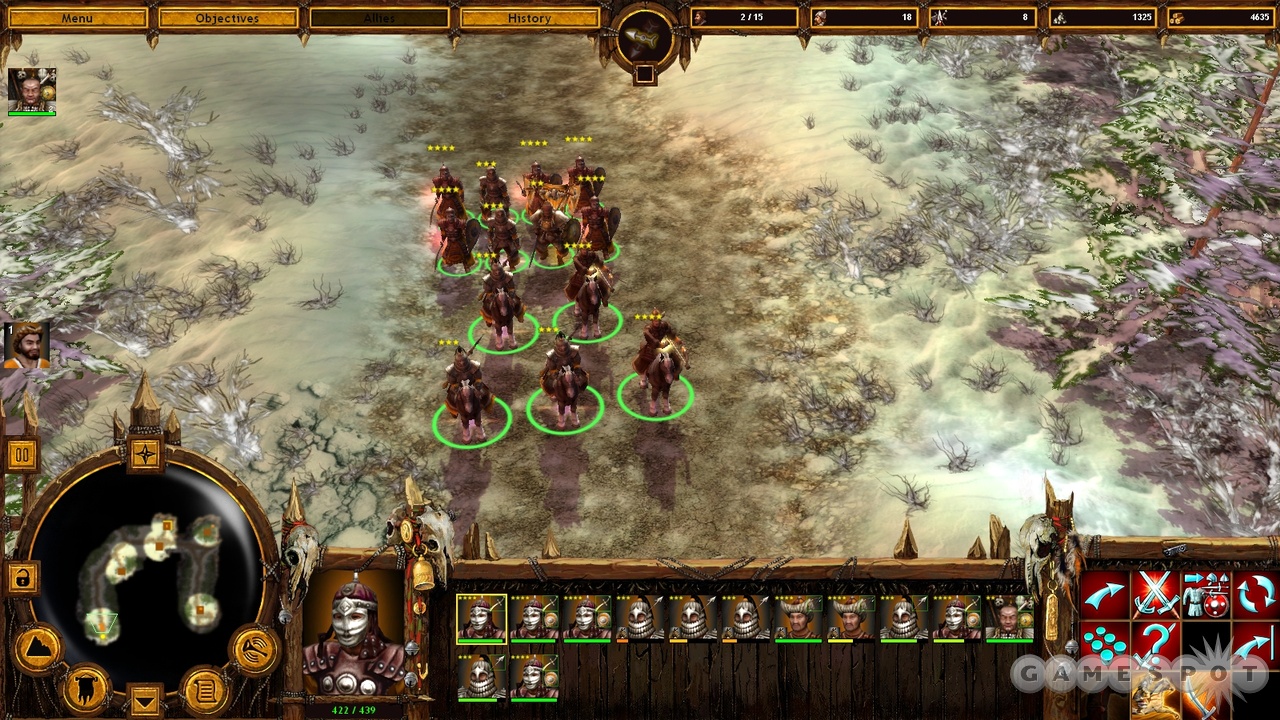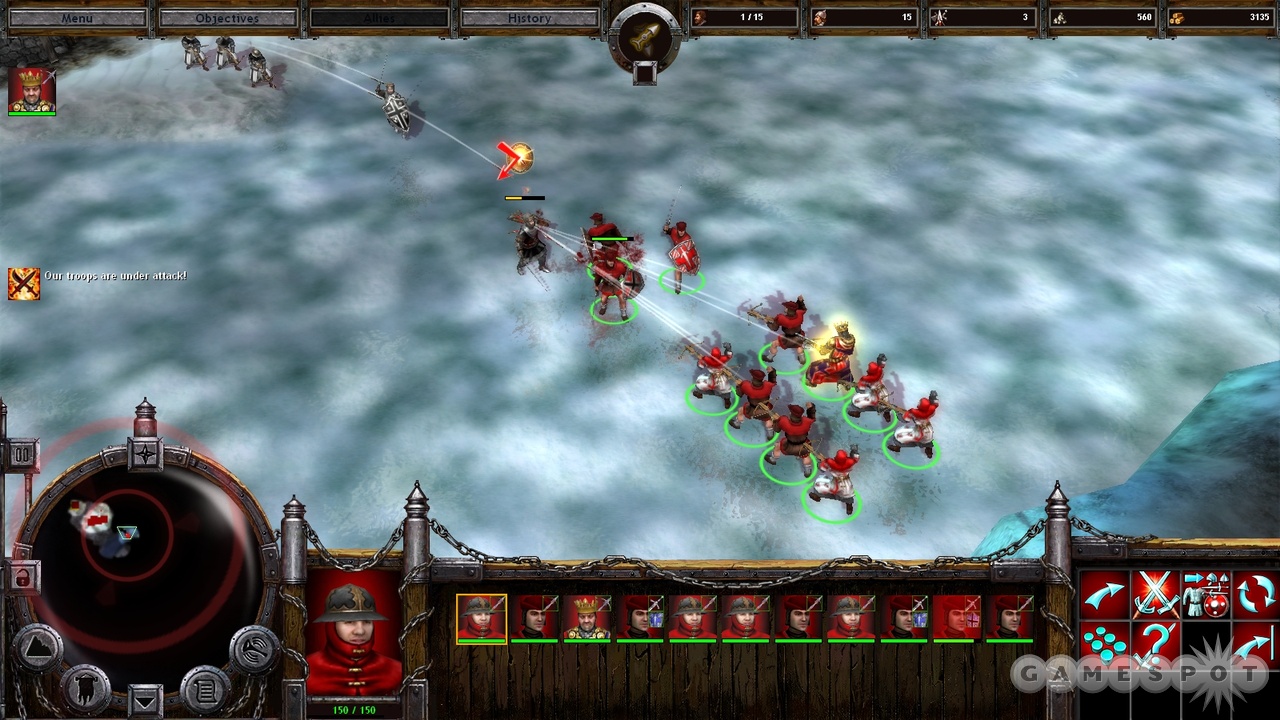Being able to guide the armies of Genghis Khan is the only real attraction in The Golden Horde. Developer World Forge's real-time re-creation of the crazy years immediately after Genghis Khan pillaged his last town is just about as mediocre as the developer's last effort: this past spring's Great War Nations: The Spartans. This is essentially a straight-up sequel built atop the same engine as its predecessor, with many of the same issues relating to tedious micromanagement and sluggish paint-by-numbers real-time strategy gameplay. Some aspects of the design have been streamlined, making for a more playable game, although all of the pillaging and burning here still generates more yawns than thrills.
With that said, the idea behind The Golden Horde is a great one. The basic design is strictly by the book, with everything laid out along the same lines as something like Age of Empires, but the subject matter is unique for RTS gaming. Battlegrounds are all little-examined ones from Eastern Europe and Western Asia fought over during the tumultuous 13th century immediately after the death of Genghis Khan left his many legions of smelly barbarians without a pillager-in-chief. Despite the name, however, the game deals with more than just the Mongol armies. Three factions are included here--the post-Genghis Mongols, the Russians of the Duchy of Ryazan, and the Teutonic Knights Crusaders. Each side plays the starring role in a solo campaign dealing with different perspectives on the Mongol invasion of the 1200s. So the Mongols attack Russia, the Russians defend against the Mongols, and the Teutonic Knights seek to round up support to drive the Mongols out of Hungary. Each campaign is completely independent and can be played at any time. This leaves you free to bounce among swarthy barbarians, swarthy Slavs, and swarthy Germans at will. There are just 14 missions in the game, along with the ability to play custom matches over LANs (there is no online support) with up to eight players, although the huge maps mean that you can get a good couple of dozen hours of playing time out of the game.

But even with the inclusion of multiple nations, there isn't a lot of historical flavor to be found here. Missions are not drawn from specific battles, leaving you little sense of what actually took place during the Mongol attacks of the 13th century. Context is seriously lacking in mission introductions. You generally only know that you have to beat back the bad guys and then raze their settlements to the ground. Lack of variety, when it comes to how the nations play, is an even bigger problem. Each side builds very similar bases, collecting the same metal and wood resources used for constructing buildings, as well as equipping troops, in the exact same way. Sure, the Mongols have nomad-friendly mobile tent buildings, while the Russians and Crusaders are all about permanent fortresses with distinctive architecture, such as Kremlin-style towers. All of these buildings and units look pretty spiffy for a budget game as well. They give structures and troops unique visuals; for example, you'll never mistake a khan's tent for a Russian town. Audio sets the factions apart, too, with Mongol units praising the khan and the Christian Crusaders mouthing such lines as "Pray more often, or you'll go to hell!" But this distinctiveness is only skin deep. The Mongol missions don't force you to utilize their nomadic attributes, while the Crusaders and the Russians are both founded on traditional base-building RTS lines. So the basic style is pretty much identical across the board. You set up shop, send peasants off to cut wood and work in a metal mine, then start cranking out the soldiers, no matter if you're a wandering Mongol or a God-fearing Crusader.
Cranking out those troops has its merits, though. As with The Spartans, the big gimmick in The Golden Horde is being able to customize armies as you see fit by giving troops specialized weapon and armor loadouts. Each nation comes with just one or two basic professional soldier types, forcing you to rely on creating citizen armies. So instead of choosing from lists of pre-rolled troops as in a standard base-building RTS, you pick average Joes then equip them with various swords, pikes, bows, shields, and armor. As the Mongols, for instance, you take Aduuch horse wrangler laborers and turn them into warriors simply by handing out weapons, such as yataghan scimitars or bulgar pikes. You also have the option of converting foot soldiers into cavalry units by plopping them onto horses you create in the stable. Then, you send these homebrewed troops into the field, often behind powerhouse hero units, where they gain battle experience and soon turn into set unit classes based on the weapons they wield. Once you reach the first level, there is no turning back, so you have to choose wisely.
Sound like a more authentic way of building an army than what goes on in the traditional base-building RTS? It is, but this realism is not without some flaws. While the developers have thankfully eliminated the multipart weapon research that sent The Spartans into micromanagement hell, everything here is still awfully involving. Having to keep an eye on multiple production lines just to equip a single class of troops is a real pain. You need to recruit workers in one building, as well as oversee weapon and armor construction in another. You also need roll out the horses in one more building and, of course, watch over the frontiers in case the enemy attacks. It's all very tedious because of the sluggish pace of all building and unit construction. You could practically run to the kitchen and bake a loaf of bread in the time it takes a hero to capture an enemy building or a peasant to build a forge. There are no adjustable speed settings, either, so you can't make things zip along when it's really needed, as in the early stages of a level when all you're doing is waiting for buildings to be completed.

Also, it's not like you can create wildly unique units. The ability to scavenge items dropped by vanquished enemies can help you create some interesting soldiers, although generally, you'll skip this annoying busywork (the automated function where you assign a worker to gather abandoned weapons and armor doesn't seem to work, so you have to manually pick up every stray sword or pike) for just setting up templates in the barracks buildings available to each faction. Then, you can pump out troops automatically. In the end, this customization rigmarole leaves you with units that fight and look a whole lot like generic spearmen, knights, crossbowmen, or cavalry from any of a hundred traditional RTS games. It hardly seems worthwhile spending so much time screwing around with so much custom-outfitting stuff when this is the final result.
Battles in The Golden Horde would probably seem to drag on forever even without these tiresome soldier customizations. While missions aren't as mind-numbing as the wham-bam, kill-everybody stuff in The Spartans, they have been pushed too far in the opposite direction and turned into plodding, dull affairs. This is good in that you now have the time to fuss around with your armies and kit them out in various ways; but it's bad in that you now have so much time to fuss around with your armies that you might wind up falling asleep. Missions also involve a great deal of repetition because you generally build the same bases and grind out the same troops in every single scenario. The only saving grace is a varied chain of objectives that sees you attacking, defending, sneaking around, and searching out allies. At least you're not always just mindlessly battling enemies. And those enemies are not mindless this time around, either. You still can't call the opposing AI brilliant or anything, but at least now it seems to function partially independent of battlefield triggers and is extremely aggressive when it comes to pursuing hostiles that try to retreat in the midst of battle. Think twice before letting loose with that volley of arrows or you might just find yourself chased all over the map.
Unless you're a history fanatic who is big on the Mongol invasions of the 13th century, it's safe to give The Golden Horde a pass. Enough changes have been made to elevate this game beyond its classical predecessor, The Spartans, but only marginally. Everything about this RTS is a blend of been-there, done-that formula and new features that don't quite work. It's hard to believe that the atrocities of Genghis Khan and his successors could ever be boring, but, well, there you have it.